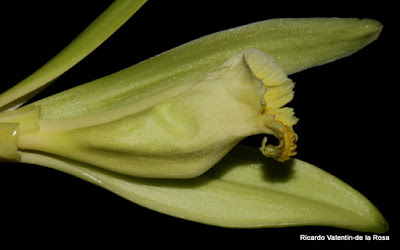 |
I found this
orchid some years ago during a hike in the Rio Abajo forest. The orchid was growing over several living
trees, on stumps and on some places crawling over the fallen branches and the leaf
litter. In this small spot of the
forest the stems of this orchid were all over the place. However my enthusiasm over finding this plant
was tempered by the fact that I could not find any evidence that the stems that
were under eye height, and therefore accessible to being photographed, had ever
bloomed. Some of the stems were fifty or
more feet up in the trees and I surmised that it was there, where the plant was
exposed to the greatest sunlight, that the flowers were produced.
I visited the
plants every year on what I suspected was its blooming season, but I could not
locate any evidence that it had bloomed.
Then about two weeks ago, I noticed that some of the stems were producing
inflorescences, luckily a few were low enough that I could take photos of the
flowers.
The flowers
last a single day, I have noticed that the inflorescences have one flower open
at a time. The inflorescences attract
ants, you can see them around the bases of the flower buds. The inflorescences are not uniformly
distributed through the stems. Almost
all of the inflorescences I found were on the stems that were getting the most
sun. None of the stems that were growing
on the deep shade had flowers and neither did the undersized stems that were
crawling on the ground.
This orchid is
used to produce commercial vanilla, it is native of Mexico. This orchid seems to be doing quite well on
its own. I have only found a single
seedling, it growing at the base of a huge teak tree. Unfortunately, the small plant didn’t survive
when snails attacked it. All the other
plants I have seen have been either large adults or pieces that have fallen
from the canopy and are starting to produce roots and climbing growths.


















No comments:
Post a Comment